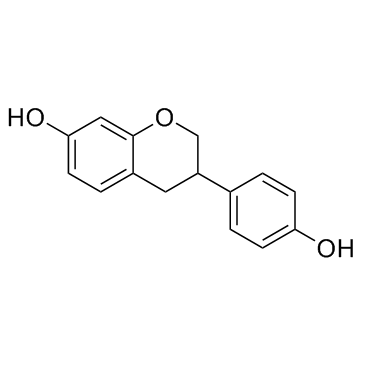| Description |
(±)-Equol is the racemate of equol. Equol is a metabolite of the soy isoflavones, daidzin and daidzein.
|
| Related Catalog |
|
| In Vitro |
Equol is first isolated and identified from pregnant-mares' urine and later found in the urine of the goat, cow, hen and sheep[1]. Equol, unlike the soy isoflavones daidzein or genistein, has a chiral center and therefore can occur as 2 distinct diastereoisomers. S-equol is the exclusive product of human intestinal bacterial synthesis from soy isoflavones and both enantiomers are bioavailable. S-equol has a high affinity for estrogen receptor beta (Ki=0.73 nM), whereas R-equol is relatively inactive[2]. Equol could promote the proliferation and differentiation of rat osteoblasts through activating the ER-PKCα-related signaling pathway. The alkaline phosphatase activity also increases significantly in all of the equol and 17β-estradiol (E2 ) groups. Equol also significantly elevates the osteocalcin levels[3].
|
| In Vivo |
Equol is a modest natriuretic and vasorelaxant agent in the rat. Orally administered equol is about 8-fold less potent than orally administered furosemide. In isolated aortic rings precontracted by administration of phenylephrine, administration of equol relaxes the contracted aorta (concentration for half-maximal activity 58.9±16 μM)[4]. Equol possesses anticancer activity that suppresses tumor formation via apoptosis induction in rats with DMBA-induced mammary gland tumors. In addition, equol shows a hepatic protective effect by acting as an antioxidant and by reducing apoptosis[5].
|
| Cell Assay |
Primary rat osteoblasts are treated with 0.01-1 μM equol, 0.01-1 μM E2 , or 0.01-1 μM equol/E2 combined with 1 μM ICI182780 for 24 or 48 hours. Then 10 mL 5 mg/mL MTT solution is added to each well. The plates are incubated at 37°C for 4 h, and then the supernatant is discarded and 100 mL DMSO is added to each well and mixed thoroughly before taking measurements in a microplate reader[3].
|
| Animal Admin |
Rats: Equol or furosemide is administered orally at doses of 16, 40, and 100 mg/kg (in a volume of 16 mL/kg 5% arabic syrup) to groups of 3-9 rats (rats of a control group are administered vehicle only). Urine samples are collected for 6 h. Urinary sodium and potassium contents are measured by flame photometry[3]. Mouse: Equol is dissolved in water and administered orally to rats at a dose of 5 and 25 mg/kg BW for 8 weeks after a single dose of DMBA (100 mg/kg). As controls, rats are divided into vehicle alone and DMBA alone groups. In the second part, ICR mice are orally administered equol daily at a dose of 5 and 25 mg/kg BW for 7 weeks before a single dose of DMBA (34 mg/kg/week). After equol administration animals are followed for 1 week continuously. The control groups are the same as above and each group are comprised of six mice. Mice livers and mammary gland tumors are isolated, blotted, weighed, frozen in liquid nitrogen and stored at -70°C until assayed[5].
|
| References |
[1]. Axelson M, et al. The identification of the weak oestrogen equol [7-hydroxy-3-(4'-hydroxyphenyl)chroman] in human urine. Biochem J. 1982 Feb 1;201(2):353-7. [2]. Setchell KD, et al. S-equol, a potent ligand for estrogen receptor beta, is the exclusive enantiomeric form of the soy isoflavone metabolite produced by human intestinal bacterial flora. Am J Clin Nutr. 2005 May;81(5):1072-9. human intestinal bacterial flora. [3]. Wang J, et al. Equol promotes rat osteoblast proliferation and differentiation through activating estrogen receptor. Genet Mol Res. 2014 Jul 4;13(3):5055-63. [4]. Gimenez I,et al. Renal and vascular actions of equol in the rat. J Hypertens. 1997 Nov;15(11):1303-8. [5]. Choi EJ, et al. Anticancer mechanism of equol in 7,12-dimethylbenz(a)anthracene-treated animals. Int J Oncol. 2011 Sep;39(3):747-54.
|


